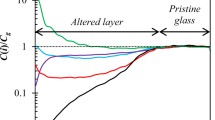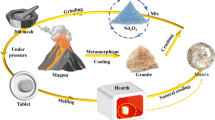Abstract
For long life nuclear wastes (essentially actinides) research is in progress to propose new matrices with an improvement of the chemical durability. High silica content glasses present high chemical durability, and we describe a process to prepare silica glass embedding the nuclear waste. Porous silica (gel) is used as a host matrix for nuclear waste. Neodymium oxide and cerium oxide are used to simulate the actinide oxides. The gel is soaked in a solution containing the simulant in nitrate salt form.
We investigate the effect of the porous network features (pore size distribution) on the ability of the material to soak up the simulating salts. A new kind of gel (composite aerogel) is proposed owing to its large permeability. After drying and nitrate decomposition, the composite material is fully sintered trapping the nuclear waste.
The glass-ceramic materials (silica glass + simulating oxide) have been synthesized with simulant content close to 20 weight percent. We show that the 2 simulant oxides behave differently because of their ability to form silicate phases. The chemical durability of the glass-ceramics is investigated. The large improvement of the chemical durability (60 times) compared to the classical borosilicate glasses shows that this containment process can be a suitable way to confine actinides and long life nuclear wastes.
Similar content being viewed by others
References
N. Jacquet-Francillon, R. Bonniaud, and C. Sombret, Radiochimica Acta 25, 231 (1978).
T. Woignier, J. Reynes, J. Phalippou, J.L. Dussossoy, and N. Jacquet-Francillon, J. Non Cryst. Solids 225, 353 (1998).
J.F. Brinker and G.W. Scherer, Sol-Gel Science (Academic Press, 1990).
J. Phalippou, T. Woignier, and M. Prassas, J. Mater. Sci. 25, 3111 (1990).
T. Woignier, J. Phalippou, J.F. Quinson, M. Pauthe, M. Repellin-Lacroix, and G.W. Scherer, J. Sol-Gel Sci. Techn. 2, 277 (1994).
E.M. Rabinovich, A.J. Bruce, and N.A. Kopylov, J. Non Cryst. Solids 160, 126 (1993).
M. Toki, S. Miyashita, T. Takeuchi, and S. Kanabe, J. Non Cryst. Solids 110, 479 (1988).
J. Reynes, Ph.D. thesis, Montpellier (1998).
C. Fillet, J. Marillet, J.L. Dussossoy, F. Pacaud, N. Jacquet-Francillon and J. Phalippou, in 99th Annual Meeting on Ceramics of the American Ceramic Society, Cincinatti, 1997.
G.W. Scherer, J. Amer. Ceram Soc. 60, 237 (1977).
R.C. Bunker, J. Non-Cryst. Solids 179, 300 (1994).
R.K. Iler, The Chemistry of Silica (Wiley, New York, 1979).
Author information
Authors and Affiliations
Rights and permissions
About this article
Cite this article
Woignier, T., Reynes, J., Phalippou, J. et al. Nuclear Waste Storage in Gel-Derived Materials. Journal of Sol-Gel Science and Technology 19, 833–837 (2000). https://doi.org/10.1023/A:1008784822052
Issue Date:
DOI: https://doi.org/10.1023/A:1008784822052




